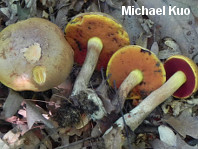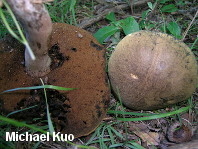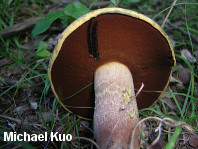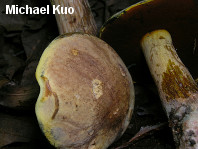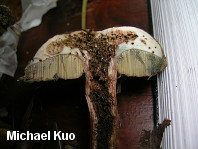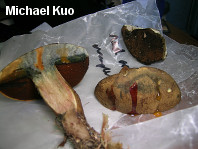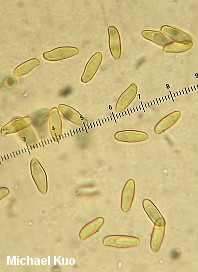| Major Groups > Boletes > Red-Pored Boletes > Boletus vermiculosoides |

|
Boletus vermiculosoides [ Basidiomycota > Boletales > Boletaceae > Boletus . . . ] by Michael Kuo This member of the Boletus vermiculosus species group, like the other species in the group, is a hardwood-associated, Midwestern and eastern North American species that stains blue and features a non-reticulate stem, as well as a pore surface that is very dark red when in the button stage, but soon fades to a dirty orangish color. The whole group is in serious need of contemporary, DNA-informed study, so identifications should probably be seen as tentative. That said, the characters that separate Boletus vermiculosoides from the others in the group are: a cap that is lighter brown at maturity than Boletus vermiculosus, and which often features a yellow marginal zone (the cap can even be yellow overall when very young); shorter, skinnier spores; and, according to the researchers who named the species (Smith & Thiers, 1971), a pileipellis that is "never a trichoderm." I have doubts about that last character (see below if you care), but I agree that the other characters seem to separate a morphological species pretty clearly. Peck (1872) originally described Boletus vermiculosus as having a cap that was "grayish-brown, tinged with red" and flesh that was "whitish." Smith & Thiers (1971) studied Peck's type collection and found the spores to measure 11-15 x 4-5.5 (6) µ; the pileipellis was "a distinct trichodermium." Interpreting Peck's species narrowly, they erected two new species to account for slightly different collections they had made from Michigan: Boletus vermiculosoides (spores 9-12 x 3-3.5 µ; pileipellis a cutis, "never a trichodermium"; young cap yellow) and Boletus subgraveolens (spores 10-13 x 3.5-4.5 µ; cap brown and slightly sticky; odor of dried specimens strong and unpleasant; pileipellis a "trichodermium [?] but soon collapsing," with nearly cystidioid terminal elements). Yes, that's their question mark. Several field guide authors have popularized the name Boletus vermiculosoides since Smith & Thiers originally published the name. Perhaps the type collection of Boletus vermiculosoides included only specimens in which the pileipellis elements were repent, indicating a cutis; I have not studied it. But Smith & Thiers studied only the one collection before declaring that the elements would "never" be erect, even though they admit in their description of Boletus subgraveolens that the trichoderm-cutis distinction can be confusing, and dependent on maturity of the specimen. Their other collections of Boletus vermiculosoides were all made after they wrote the description; it would be interesting to see if these collections, like mine, include both cutis-like and trichoderm-like caps (in fact, in several of my collections, the two types of pileipellis can be found on the same cap). Description: Ecology: Mycorrhizal with oaks; growing alone, scattered, or gregariously in oak-hickory forests; summer; probably widely distributed east of the Rocky Mountains. Cap: 4-13 cm; convex, becoming broadly convex; dry; dull; soft; finely, innately fibrillose; olive brown to medium brown or grayish brown, fading to tan; often with a yellow marginal zone, or nearly yellow overall when young--but the yellow quickly becoming brown (in some of my collections the yellow has disappeared completely only a few hours after collecting); when fresh bruising blue to black. Pore Surface: Dark red-brown to maroon when young, but quickly fading to dull brownish orange; bruising promptly dark blue or black; pores round, 2-3 per mm; tubes dull yellowish, to about 2 cm deep. Stem: 7-10 cm long; up to about 2 cm thick; slender; more or less equal; covered with tiny tufts of fibers that become brownish when handled; brownish overall, with a yellowish apex and, sometimes, a pale reddish zone; not reticulate; basal mycelium whitish. Flesh: Whitish or yellowish in cap; yellowish in upper stem; staining sky blue in cap and red in stem when sliced; often becoming riddled with worms and decaying quickly. Odor and Taste: Not distinctive. Chemical Reactions: Ammonia reddish on cap surface; orangish on flesh. KOH dark red on cap surface; orange on flesh. Iron salts negative to greenish on cap surface; negative on flesh. Spore Print: Olive brown. Microscopic Features: Spores 9-12 x 3-4.5 µ; smooth; subfusiform; yellowish in KOH. Hymenial cystidia mostly fusoid-ventricose; yellow in KOH; to about REFERENCES: Smith & Thiers, 1971. (Smith, Smith & Weber, 1981; Both, 1993; Bessette, Roody & Bessette, 2000; Roody, 2003; Binion et al., 2008.) Herb. Kuo 07039702, 07230309, 07110703, 06291101, 09121205. This site contains no information about the edibility or toxicity of mushrooms. |
© MushroomExpert.Com |
|
Cite this page as: Kuo, M. (2013, December). Boletus vermiculosoides. Retrieved from the MushroomExpert.Com Web site: http://www.mushroomexpert.com/boletus_vermiculosoides.html |
